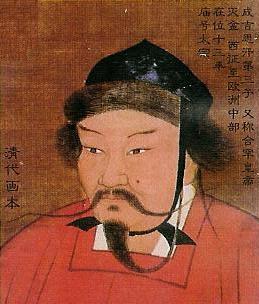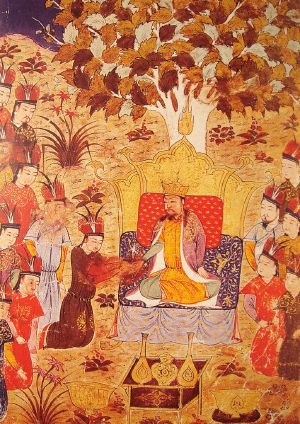Difference between revisions of "Ögedei Khan" - New World Encyclopedia
(credit Wiki) |
|||
| Line 1: | Line 1: | ||
{{Infobox_Monarch|name=Ogedei Khan | {{Infobox_Monarch|name=Ogedei Khan | ||
| − | |title= | + | |title=Khagan of the [[Mongol Empire]]<br>(Khan of the [[Mongols]]) |
|image=[[Image:Ogadai Khan.jpg]] | |image=[[Image:Ogadai Khan.jpg]] | ||
|caption= | |caption= | ||
|reign=1229 – 1241 | |reign=1229 – 1241 | ||
|coronation=1229 | |coronation=1229 | ||
| − | |given name=Ogedei | + | |given name=Ogedei Khan<br>Chinese: 窩闊臺 |
|predecessor=[[Genghis Khan]] | |predecessor=[[Genghis Khan]] | ||
|successor=[[Güyük Khan]] | |successor=[[Güyük Khan]] | ||
| − | |consort= | + | |consort=Töregene |
| − | |royal house= | + | |royal house=Borjigin<br>Chinese: 孛兒只斤氏 |
| − | |father= | + | |father=Genghis Khan |
| − | |mother= | + | |mother=Borte Ujin |
|date of birth=c. 1186 | |date of birth=c. 1186 | ||
|date of death=1241 | |date of death=1241 | ||
| Line 18: | Line 18: | ||
|}} | |}} | ||
| − | '''Ögedei Khan''', | + | '''Ögedei Khan''', }, ''Ögedei''; also '''Ogotai''' or '''Oktay''', c. 1186 – 1241), was the third son of [[Genghis Khan]] and second Great Khan of the [[Mongol Empire]] by succeeding his father. He continued the expansion of the empire that his father had begun, and was the Great Khan when the Mongol Empire reached its furthest extent west during the [[mongol invasion of europe|invasion of Europe]]. Like all of Genghis' primary sons, he participated extensively in conquests in Western China and Central Asia. |
==Background== | ==Background== | ||
Revision as of 23:40, 8 October 2008
| Ogedei Khan | ||
|---|---|---|
| Khagan of the Mongol Empire (Khan of the Mongols) | ||

| ||
| Reign | 1229 – 1241 | |
| Coronation | 1229 | |
| Born | c. 1186 | |
| Died | 1241 | |
| Predecessor | Genghis Khan | |
| Successor | Güyük Khan | |
| Consort | Töregene | |
| Royal House | Borjigin Chinese: 孛兒只斤氏 | |
| Father | Genghis Khan | |
| Mother | Borte Ujin | |
Ögedei Khan, }, Ögedei; also Ogotai or Oktay, c. 1186 – 1241), was the third son of Genghis Khan and second Great Khan of the Mongol Empire by succeeding his father. He continued the expansion of the empire that his father had begun, and was the Great Khan when the Mongol Empire reached its furthest extent west during the invasion of Europe. Like all of Genghis' primary sons, he participated extensively in conquests in Western China and Central Asia.
Background
Ögedei was the third son of Genghis Khan, and was considered to be his father's favorite son, ever since his childhood. As an adult Ögedei was known for his ability to sway doubters in any debate in which he was involved, simply by the force of his personality. He was a physically big, jovial and very charismatic man, who seemed mostly to be interested in enjoying good times. He was intelligent and steady in character. His charisma was partially credited for his success in keeping the Mongol Empire on the path that his father had set.
Ögedei was also known to be a humble man, who knew his human limitations, did not believe himself to be a genius, and was willing to listen and use the great generals that his father left him, as well as those he himself found to be most capable. Like all Mongols at his time, he was raised and educated as a warrior from childhood, and as the son of Genghis Khan he was a part of his father's plan to establish a world empire. His military experience was notable for his willingness to listen to his generals, and adapt to the circumstances. He was an extremely pragmatic person, much like his father, and looked at the end, rather than the means. His steadiness of character and dependability were the traits that his father most valued, and that gained him the role of successor to his father, despite his two older brothers.
Ascendancy to Supreme Khan
He was elected supreme khan in 1229, according to the kurultai held after Genghis' death, although this was never really in doubt as it was Genghis' clear wish that he be succeeded by Ögedei. His charisma is partially credited for his success in keeping the Empire on his father's path. Thanks mostly to the organization left behind by Genghis Khan, and the personal charisma of Ögedei, the affairs of the Mongol Empire remained for the most part stable during his reign. To this it must again be added that Ögedei was an extremely pragmatic man, and knew his limitations. He had no delusions that he was his father's equal as a military commander or organizer, and used the abilities of those he found most capable.
In 1235, he finished Karakorum, the capital of Mongol Empire.
During his reign, the Mongols completed the destruction of the Jurchen Jin empire (in 1234), coming into contact and conflict with the Southern Song. In 1235, under the khan's direct generalship, the Mongols began a war of conquest that would not end for forty-five years, and would result in the complete annexation of all of China. Mongol armies vassalized Korea, established permanent control of Persia proper (commanded by Chormagan) and, most notably, expanded westward under the command of Batu Khan to subdue the Russian steppe. Their western conquests included almost all of Russia (save Novgorod, which became a vassal), Hungary, and Poland. Ögedei's sons Kadan and Güyük attacked Poland and Transylvania, respectively.
Ögedei Khan had granted permission to invade the remainder of Europe, all the way to the "Great Sea," the Atlantic Ocean, and only his death prevented the possible invasions of Austria, Germany, Italy, France, and Spain, and the remaining small European principalities. Indeed, Mongol forces were moving on Vienna, launching a fierce winter campaign against Austria and Germany in the first wave into Western Europe, when Ögedei died. Some historians believe only his death prevented the complete conquest of Europe.
The Mongol expansion throughout the Asian continent under the leadership of Ögedei helped bring political stability and re-establish the Silk Road, the primary trading route between East and West.
Aftermath of Ögedei's death
Ögedei's death in 1241 brought the Mongol invasion of Europe to a premature end. The commanders heard the news as they were advancing on Vienna, and withdrew for the Ikh kurultai in Mongolia, never again to return so far west.[citation needed]
His son Güyük eventually succeeded him after the five-year regency of his widow Töregene Khatun. But Batu Khan, Khan of the Kipchak Khanate in Russia, never accepted Guyuk, who died on the way to confront him. It was not until 1255, well into the reign of Mongke Khan, that Batu felt secure enough to again prepare to invade Europe. Fortunately for the Europeans, he died before his plans could be implemented. His son intended to carry them out, but he also died, and in 1258, Batu's brother Berke, ascended to the Kipchak Khanate. A Muslim, he was more interested in stopping his cousin Hulagu from doing any more damage to the Holy Land than invading Europe. Historians mark the decline of the united Mongol Empire from Ogedei's death, though Mongke's ascension halted the interfamilial fighting for a time.
At the death of Mongke, Mongke's youngest brother Arik Boke was declared the Great Khan. Then there was 4-year long civil war between Arik Böke and Kublai Khan, who was also Mongke's brother. Eventually, Kublai Khan won. Kaidu, a descendant of Ogedei, refused to recognize Kublai Khan as the Great Khan. This started many battles between Kaidu and Kublai Khan. After Kaidu's son, Ogedei's line basically finished in the struggle for power. The unity of the Mongols ended because of the power struggle among the various Mongol princes. Kublai Khan's descendants were recognized as the Great Khan only in Mongolia and China and the surrounding areas.
ReferencesISBN links support NWE through referral fees
- Amitai-Preiss, Reuven, The Mamluk-Ilkhanid War, 1998
- Chambers, James, The Devil's Horsemen: The Mongol Invasion of Europe
- Hildinger, Eric, Warriors of the Steppe: A Military History of Central Asia, 500 B.C.E. to A.D. 1700
- Morgan, David, The Mongols, ISBN 0-631-17563-6
- Nicolle, David, The Mongol Warlords Brockhampton Press, 1998
- Reagan, Geoffry, The Guinness Book of Decisive Battles , Canopy Books, NY (1992)
- Saunders, J.J., The History of the Mongol Conquests, Routledge & Kegan Paul Ltd, 1971, ISBN 0-8122-1766-7
- Sicker, Martin, The Islamic World in Ascendancy: From the Arab Conquests to the Siege of Vienna, Praeger Publishers, 2000
- Soucek, Svatopluk, A History of Inner Asia, Cambridge, 2000
External links
| House of Borjigin (Боржигин) (1206-1402) Born: 1186; Died: 1241 | ||
|---|---|---|
| Regnal Titles
| ||
| Preceded by: Genghis Khan |
Great Khan of Mongol Empire 1229-1241 |
Succeeded by: Güyük Khan |
Template:Khagans of Mongol Empire
| Mongol Empire | ||||||
|---|---|---|---|---|---|---|
| Politics, organization and daily life | Military Campaigns | People | Terms | |||
Khanates
Notable cities |
Asia
|
Emperors and rulers
Prominent military generals
|
Titles
Political and military terms
| |||
Template:Yuan Emperors
ar:أوقطاي خان bg:Угедей хан ca:Ogodei de:Ögedei Khan es:Ogodei fa:اوگتایخان fr:Ögödei gl:Ögödei ko:우구데이 칸 id:Ogadai Khan it:Ögödei he:אוגדיי חאן hu:Ögödej kán mr:ओगदेई खान mn:Өгөөдэй хаан nl:Ögedei Khan ja:オゴデイ no:Ögedei pl:Ugedej pt:Ogedei ru:Угэдэй simple:Ögedei Khan sk:Ogotaj fi:Ögödei-kaani sv:Ögedei vi:Oa Khoát Đài tr:Ögeday ur:اوکتائ خان zh:窝阔台
Credits
New World Encyclopedia writers and editors rewrote and completed the Wikipedia article in accordance with New World Encyclopedia standards. This article abides by terms of the Creative Commons CC-by-sa 3.0 License (CC-by-sa), which may be used and disseminated with proper attribution. Credit is due under the terms of this license that can reference both the New World Encyclopedia contributors and the selfless volunteer contributors of the Wikimedia Foundation. To cite this article click here for a list of acceptable citing formats.The history of earlier contributions by wikipedians is accessible to researchers here:
The history of this article since it was imported to New World Encyclopedia:
Note: Some restrictions may apply to use of individual images which are separately licensed.
